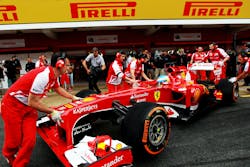Formula One returns to Europe for what is traditionally a key race: the Spanish Grand Prix. The Montmelo circuit is familiar to the teams and they frequently use the return to Europe to introduce significant car upgrades, designed to improve performance and increase downforce.
This often adds to the demands placed on the tires at what is already a high-energy circuit because of the fast, sweeping corners that put extreme forces through the tires. As a result, Pirelli will bring the two hardest compounds in the Formula One range.
Paul Hembery, Pirelli motorsport director:
“It’s often said that Barcelona provides the most accurate representation of the form a season will take, because a car that performs well in Barcelona should perform well everywhere. The same is true of the tires, because the Spanish circuit is one of the most demanding circuits we race on all year. Long and fast corners such as Turn Three put a huge amount of energy into the tires, as a result of which degradation is high. The track surface is also quite abrasive, and ambient temperatures can be high, which increase the workload on the tires further. In the past we’ve seen up to four pit stops in Spain. With the changes we have made to the tires this year, we would now hope to see no more than three for the majority of drivers. We made a solid start to our preparations for next year with the first dedicated in-season tire tests in Bahrain. We’re looking forward to building on that work with four teams in Spain after the grand prix.”
The circuit from a tire point of view:
While Barcelona has traditionally been used for pre-season winter testing for as long as most drivers can remember, this was not actually the case this year, when pre-season testing took place in Jerez and Bahrain. As a result, the teams and Pirelli come to Barcelona with no information about the new generation of cars on the circuit.
The left side of the car is worked particularly hard in Spain, with heavy traction demands on the left-rear tire in particular. The lateral forces acting on both left tires are the second highest of the entire year. The high energy loads going through the compounds means that the surface of the tire can reach a maximum temperature of 130 degrees centigrade. There is just one long straight, so the tires do not have much of a chance to cool down over the course of a lap.
The hard tire is a high-working range compound, designed for the hottest and most extreme conditions of the year, while the medium tire is a low working range tire, designed to work effectively in an ample variety of conditions. This combination ensures that there is always a solution for the wide range of conditions that can be seen in Barcelona.
Eight of the last 10 races in Barcelona have been won from pole position, underlining the importance of qualifying and the difficulty in overtaking at the Spanish track. As a result, strategy can be crucial to gain track position, as the 2013 race showed. Last year, Fernando Alonso won the race for Ferrari with a four-stop sprint strategy, defeating Kimi Raikkonen (Lotus) in second, who stopped three times. Alonso set a new record, becoming the only driver to win a grand prix at the Montmelo circuit from as far down as fifth on the grid.



